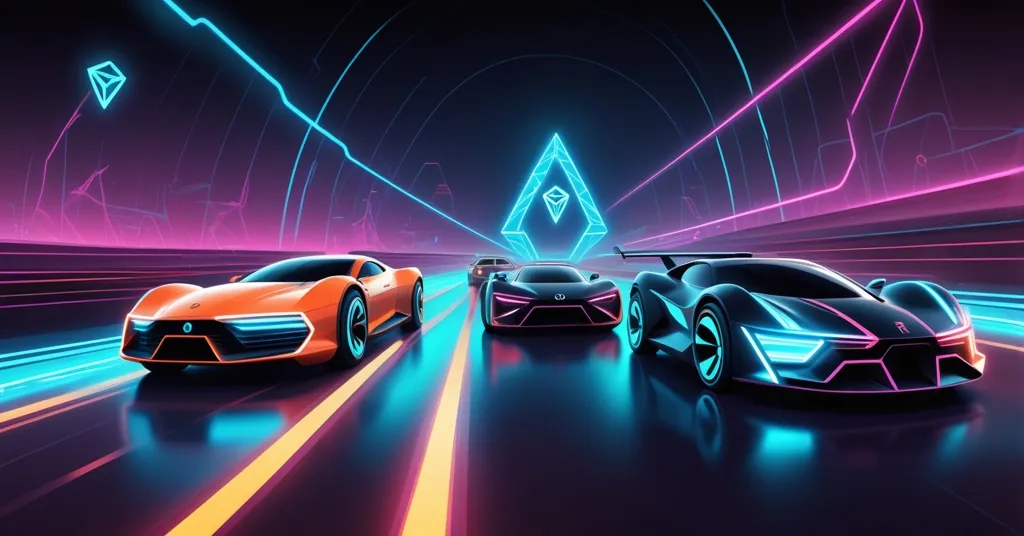Tron Hits $0.27, Cardano Targets $0.73, BlockDAG Presale Sparks 27x Return Hype

Tron Surges to $0.27, Cardano Aims for $0.73, While BlockDAG’s $0.0018 Presale Fuels Risky 27x Return Speculation
Bitcoin continues to anchor the crypto market as the ultimate symbol of decentralization, but altcoins are carving out their own narratives with a mix of utility and speculation. Tron (TRX) has climbed to $0.27, overtaking Cardano (ADA) in market cap with a staggering volume of USDT transactions, while Cardano pushes toward $0.73 on the back of technical upgrades and strong staking. Meanwhile, BlockDAG (BDAG), a presale project at just $0.0018, is generating buzz with promises of turning $1,000 into $27,777—or more—if its lofty projections come true. Let’s dive into the momentum, the challenges, and the outright gambles shaping these projects.
- Tron (TRX) at $0.27 eclipses Cardano’s market cap with $25.77 billion, driven by massive USDT volume, though questions of sustainability linger.
- Cardano (ADA) nears $0.73 with robust staking and scalability upgrades, yet faces pressure to keep pace with faster rivals.
- BlockDAG (BDAG) presale at $0.0018 promises 27x returns at a $0.05 listing, but unproven claims demand extreme caution.
Bitcoin’s Lens: Setting the Standard for Decentralization
As a champion of Bitcoin’s ethos, I view every altcoin through the prism of whether it strengthens or distracts from the mission of financial sovereignty. Bitcoin remains the gold standard—a decentralized, censorship-resistant store of value that no central bank can touch. Tron offers utility in stablecoin transfers, Cardano experiments with sustainable scalability, and BlockDAG… well, let’s just say it’s a wild card riding hype over substance so far. While innovation in the altcoin space can push boundaries in ways Bitcoin doesn’t, the core fight for freedom and privacy must not be overshadowed by speculative noise. Let’s see how these projects measure up to that ideal.
Tron: Stablecoin Giant with a Centralized Shadow
Utility Driving Market Cap Growth
Tron has hit a price above $0.27, marking a modest 1.2% daily gain but a significant milestone as its market capitalization reaches $25.77 billion, surpassing Cardano. The engine behind this surge is its dominance in stablecoin transactions, particularly USDT (Tether), a digital currency pegged to the US dollar used widely for trading and transfers due to its stability. Tron processes a reported $118 billion in daily USDT volume—though some sources suggest this might be closer to $121 billion monthly—outstripping even Ethereum in this niche. Think of Tron as a digital highway for dollar-pegged transactions, offering low fees and high speed that make it a go-to for DeFi users and traders.
On-chain data reveals whale activity, with TRON DAO, the organization guiding the network, recently moving 8.78 billion TRX. This signals either strategic reshuffling or strong confidence from big players. Add to that Tron’s expansion into the United Arab Emirates, a region embracing blockchain with progressive policies and wealth concentration, focusing on stablecoins and infrastructure. Analysts project short-term price targets between $0.32 and $0.34, with some wild long-term guesses hitting $3.55 by 2030 if adoption ramps up, as discussed in recent market analyses. The utility is clear: Tron fills a gap for cheap, fast transfers that Bitcoin, with its focus on security over speed, doesn’t prioritize.
Risks Tied to USDT’s Baggage
But let’s cut through the optimism with a dose of reality. Tron’s heavy reliance on USDT is a double-edged sword. Tether has long faced scrutiny over whether its reserves truly back every token 1:1 with dollars, and any regulatory crackdown on USDT could tank Tron’s volume overnight. If Tether stumbles, Tron’s highway risks becoming a ghost road. Moreover, while Tron markets itself as decentralized, its dependence on a centralized stablecoin raises eyebrows, as explored in community discussions on centralization concerns. Does this align with the ethos of breaking free from traditional finance, or is it just swapping one middleman for another? Bitcoin’s self-sovereignty doesn’t have this kind of baggage—Tron needs to diversify its use cases or risk being a one-trick pony.
Cardano: Slow and Steady with Scalability in Sight
Technical Foundation and Staking Strength
Cardano, trading around $0.695, is eyeing resistance levels at $0.73, $0.76, and $0.80. For newcomers, Cardano operates on a proof-of-stake (PoS) model, unlike Bitcoin’s energy-intensive proof-of-work (PoW). In PoS, users “stake” their ADA coins to validate transactions and secure the network, earning rewards in return—a greener, more sustainable approach. With over 22 billion ADA staked across nearly 3,000 active pools and 110 million transactions processed, Cardano’s community is a quiet force, with staking mechanics explained in detail for those curious.
Price-wise, ADA holds above its 200-day Simple Moving Average (SMA) of $0.659, a long-term trend indicator, and just below the 50-day SMA at $0.718, signaling short-term momentum. But the real story is in the tech. The recent Node v10.4.1 update includes UTXO-HD (Unspent Transaction Output – High Density), a tweak to optimize how transaction data is stored, cutting down on storage needs. Simulations of the Leios scaling solution have hit 1,000 transactions per second (TPS), a leap forward for a chain often criticized for speed compared to rivals like Solana, with technical breakdowns of these updates available for deeper insight. Price projections suggest $0.89 by early July, $1.25 by August, and up to $2.36 by year-end, driven by these upgrades and potential market cycles tied to Bitcoin’s 2024 halving.
Challenges in a Fast-Moving Market
Yet, Cardano’s methodical, research-heavy approach can feel like watching paint dry in a market obsessed with overnight pumps. While 1,000 TPS is impressive, Solana regularly exceeds that, and Ethereum’s post-merge upgrades keep it dominant for decentralized apps (dApps). Cardano’s slow pace risks losing mindshare to flashier competitors, even if its tech is sound, a concern highlighted in discussions on scalability hurdles. From a Bitcoin-maximalist view, ADA’s focus on scalability and sustainability complements BTC’s store-of-value narrative, offering a platform for dApps that Bitcoin isn’t built for. Still, without faster adoption, Cardano might struggle to stay relevant. Can it balance academic rigor with market demands, or will it be left behind?
BlockDAG: Presale Hype with a Side of Red Flags
The Promise of Outsized Gains
Now, onto BlockDAG—a presale project priced at a mere $0.0018 (fixed until June 13, though Batch 28 sits at $0.0262) that’s making waves with promises straight out of a daydream. The math is seductive: $1,000 buys 555,555 BDAG coins, and if the listing price reaches $0.05, that’s $27,777—a 27x return. Some even speculate a $1 price by 2026, turning that $1,000 into nearly $600,000. They’ve raised over $285 million, sold 21.8 billion coins, and pride themselves on being community-driven with no venture capital backing, a middle finger to the institutional crypto scene, though community skepticism about legitimacy persists. Listings on 20 centralized exchanges are planned, with five confirmed (MEXC, LBank, CoinStore, XT.com, BitMart) for a GO LIVE event on June 13.
Technologically, BlockDAG claims a hybrid model combining Directed Acyclic Graph (DAG)—a structure allowing parallel transaction processing for better scalability—with traditional blockchain elements. They also tout real mining options via mobile and hardware, pitching accessibility. With Bitcoin’s next halving in 2024 often sparking altcoin bull runs, BlockDAG is being hyped as a top crypto for 2025. In the spirit of effective accelerationism, pushing new tech like DAG hybrids could accelerate blockchain innovation, even if it’s a long shot.
Reality Check: A Minefield of Risks
Let’s be brutally honest: this smells like presale mania, and I’m not buying the fairy tale. A 555x jump to $1 by 2026 is pure fantasy without ironclad proof of adoption or utility. We’ve seen this movie before—ICO booms in 2017 and meme coin frenzies in 2021 left countless investors burned by projects with glossy promises but no substance. BlockDAG’s “community-driven” label is cute, but without VC backing, where’s the accountability or long-term funding to deliver? The hybrid DAG-blockchain tech sounds fancy, but it’s untested at scale—compare it to IOTA, a DAG project that’s struggled with real-world execution despite years of hype. No transparent team details, no verifiable on-chain activity, no whitepaper breakdowns that stand up to scrutiny, as pointed out in analyses of presale risks and hype. Investors chasing this are playing with fire, not a lottery ticket.
From a Bitcoin perspective, BlockDAG feels like a distraction from the real fight for decentralization. Bitcoin doesn’t need hype; it has proven resilience. If BlockDAG can’t demonstrate a clear niche beyond speculative gains, it’s just noise in a space already crowded with failed experiments. Do your own damn research—presale investments like this are a cesspool of risk, and history shows most implode. We’re all for disrupting the status quo, but not at the cost of gullible investors getting fleeced.
Broader Market Forces: Regulation and Macro Pressures
Zooming out, all three projects face external headwinds that could dwarf their internal progress. Tron’s USDT reliance puts it in the crosshairs of stablecoin regulation—governments worldwide are itching to clamp down on Tether’s opaque reserves, with reports of Tron’s massive USDT activity drawing attention to this vulnerability. Cardano, as a PoS token, might face SEC scrutiny if the agency doubles down on classifying such assets as securities. BlockDAG, if it’s even real, could get lost in the noise of a post-halving altcoin frenzy or crushed by a bear market if macroeconomic conditions (think interest rate hikes or recession fears) sour risk appetite. Bitcoin’s halving in 2024 might lift all boats temporarily, but it also reminds us that BTC’s cultural and economic staying power often overshadows altcoin experiments. These macro factors are the wild cards no project can fully control.
Key Takeaways and Questions for Crypto Enthusiasts
- What’s fueling Tron’s market cap surge past Cardano?
Tron’s processing of massive USDT volume—reported at $118 billion daily, though possibly closer to monthly figures—alongside whale activity (8.78 billion TRX moved by TRON DAO) and expansion in the UAE, has pushed its market cap to $25.77 billion, overtaking Cardano. - How does Tron’s USDT reliance impact its decentralization claims?
While Tron markets itself as decentralized, its heavy dependence on USDT, a centralized stablecoin with reserve transparency issues, undermines that narrative, risking collapse if Tether faces regulatory heat. - What technical strides are backing Cardano’s price momentum?
Cardano’s Node v10.4.1 update with UTXO-HD for storage efficiency, Leios scaling hitting 1,000 TPS in simulations, and 22 billion ADA staked across 3,000 pools provide a strong foundation for targets of $0.89 to $2.36 by year-end. - Can Cardano keep up with faster blockchain competitors?
Despite solid upgrades, Cardano’s deliberate pace risks losing ground to quicker rivals like Solana or Ethereum, which dominate in speed and dApp ecosystems, challenging ADA’s relevance despite its sustainability focus. - Why is BlockDAG drawing such intense investor interest?
With a presale price of $0.0018, potential 27x returns at a $0.05 listing, and $285 million raised through community support alone, BlockDAG taps into the allure of massive gains, positioning itself as a 2025 contender. - How realistic are BlockDAG’s projected returns of $1,000 to $27,777?
The numbers pencil out on paper, but they’re wildly speculative, hinging on unproven adoption and favorable market conditions—history shows most presale projects with such claims fail spectacularly. - What lessons from past crypto scams apply to BlockDAG investors?
Past ICO and presale flops highlight the need for due diligence—scrutinize BlockDAG’s team, tech, and transparency, as hype often masks red flags that lead to investor losses. - How do these projects align with Bitcoin’s decentralization mission?
Tron and Cardano fill niches (stablecoin transfers, scalable dApps) that complement Bitcoin’s store-of-value focus, but BlockDAG’s speculative nature risks diluting the focus on true financial sovereignty unless it proves real utility.
Navigating the crypto landscape demands a sharp eye for both opportunity and deception. Tron and Cardano offer tangible value—albeit with their own flaws—through utility and technical progress, reflecting the kind of innovation that can support Bitcoin’s broader fight against centralized control. BlockDAG, however, embodies the reckless speculation that plagues this space, tempting investors with pipe dreams while lacking substance. As advocates for decentralization, privacy, and disruption, we celebrate experiments that push boundaries but refuse to sugarcoat the risks. Crypto is a revolution, not a casino—keep your skepticism as sharp as your optimism.



